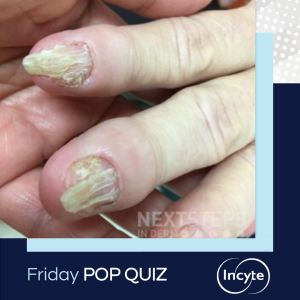
The correct answer is C. Tuberous sclerosis.
In tuberous sclerosis, ungual fibromas (Koenen tumors) begin to develop later in childhood and can continue to form throughout adulthood. Periungual fibromas arise from the proximal or lateral nail fold and occur most commonly around the toenails. In contrast, subungual fibromas that originate under the nail plate and longitudinal red streaks with proximal narrowing (“red comets”) favor the fingernails. In addition, lesions can lead to distortion of the nail plate (e.g. a longitudinal groove) without a visible tumor.
Onychomycosis causes nail dystrophy but does not usually present with longitudinal red streaks and proximal narrowing or tumors that arise from the nail fold. Pachydermoperiostosis (primary hypertrophic osteoarthropathy) is associated with facial involvement, thickening of the skin on the hands and feet, and clubbing of the digits. Multiple endocrine neoplasia (MEN) refers to a group of disorders marked by the presence of neoplasia or hyperplasia in two or more endocrine organs, often in association with mucocutaneous findings; nail findings are uncommon. The characteristic findings of neurofibromatosis include cafe-au-lait macules, neurofibromas, freckling in the axillae and groin, Lisch nodules, and bony defects. It does not commonly include nail abnormalities.
References:
MR Gomez: Phenotypes of the tuberous sclerosis complex with a revision of diagnostic criteria. Ann N Y Acad Sci. 615:1-7 1991
JP Osborne, A Fryer, D Webb: Epidemiology of tuberous sclerosis. Ann N Y Acad Sci. 615:125-127 1991 PMID 2039137
WC Wiederholt, MR Gomez, LT Kurland: Incidence and prevalence of tuberous sclerosis in Rochester, Minnesota, 1950 through 1982. Neurology. 35:600-603 1985 PMID 3982655
